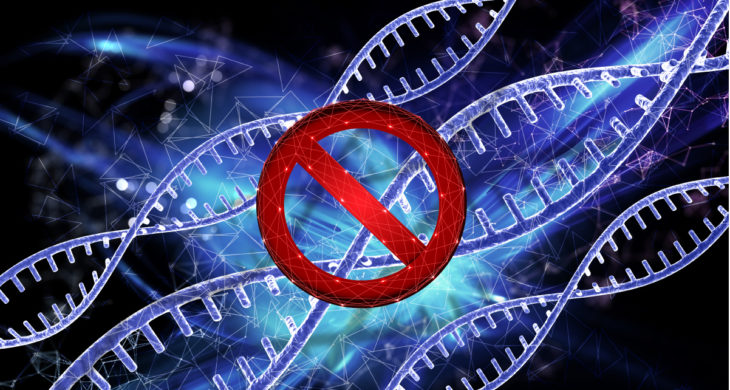
Date: 13th March 2020
Anti-CRISPRs (Acrs) are small proteins that inhibit the RNA-guided DNA targeting activity of CRISPR-Cas enzymes. Now Jennifer Doudna and colleagues have discovered three Acrs (AcrIIA13, AcrIIA14, and AcrIIA15) and have demonstrated all three are able to inhibit therapeutically significant CRISPR-Cas9 gene editing.
Several Acrs have been discovered for the currently most popular Cas9 from Streptococcus pyogenes (SpyCas9). However, there is increasing interest in Staphylococcus aureus Cas9 (SauCas9) due the fact it is highly active in human cells and its smaller size which makes it more easily deliverable.
To identify Acrs capable of inhibiting SauCas9, a team led by the CRISPR pioneer Jennifer Doudna, from the University of California, US, have used both a self-targeting CRISPR screen and guilt-by-association genomic search strategy.
Finding Acrs can be particularly challenging, they do not have conserved sequences or structure, and are relatively small in size. However, acr genes often cluster together with other acr genes or are adjacent to highly conserved Acr-associated genes (aca genes) in “acr loci” which makes them amenable to a guilt-by-association approach. It does however, require a known Acr or aca gene to seed the search.
A converse approach is to use a self-targeting CRISPR system; these are present in diverse genomes that can also encode corresponding CRISPR-Cas inhibitors which block autoimmunity. Mobile genetic elements (MGEs) harbouring a CRISPR-Cas target sequence can be incorporated into the host chromosome; whilst normally these elements are derived from invasive genetic material (phage DNA which is inserted into a CRISPR locus in the form of a spacer), in some cases they originate from the host-genome. This then directs the immune system to the host genome – leading to self-targeting and autoimmunity . In theory these self-targeting CRISPR systems should be lethal however, in some cases these MGEs, have evolved Acrs.
Acr discovery
The team therefore started by using a bioinformatic identification process using a previously developed self-targeting spacer searcher (STSS) which they queried against all Staphylococcus species. The team discovered 99 predicted instances of self-targeting in Staphylococcus CRISPR systems across 43 different strains. Following a series of filters one strain from each of two species, Staphylococcus haemolyticus and Staphylococcus schleiferi, were selected for further screening of Acrs active against SauCas9.
As nearly all currently known Acrs can be found in MGE sequences, the team searched for potential hotspots that might harbour Acrs in the two strains. The team then designed 27 genome fragment (GF) amplicons in total, covering all of the predicted sequences, fluorescent reporter assays were set up to assess the ability of the genome fragments to inhibit Cas9-mediated fluorescent knockdown. Only one fragment containing 8 genes achieved Cas inhibition. Each gene was then individually cloned and re-tested in the assay and one gene was identified as being responsible for the inhibition, AcrIIA13.
As Acrs usually cluster together, the team then used a guilt-by-association approach and searched for ‘neighbouring’ genes that are located near to AcrIIA13 in the genome and found 10 additional candidate Acr genes. These genes were then tested individually in the reporter assay to determine whether they could inhibit SauCas9, and two additional genes were identified; AcrIIA14 and AcrIIA15.
Acr distinct features
Using biochemical approaches the team then look at mechanisms of function as each SauCas9 inhibitor had distinct features and activities. Whilst AcrIIA13 prevented SauCas9-mediated dsDNA cleavage activity by blocking DNA binding, AcrIIA15 bound to SauCas9 to block RNP (ribonucleoprotein) assembly and AcrIIA14 inhibited dsDNA cleavage activity.
In human cells, the team saw potent inhibition of SauCas9, but not SpyCas9, by AcrIIA13 and AcrIIA14, suggesting both potentially have a more specific range of inhibition. However, AcrIIA15 was able to inhibit both SpyCas9 and SauCas9 in human cells, although to a lesser extent. Of the three Acrs, AcrIIA13 was the most potent inhibitor of SauCas9.
Conclusions and future applications
The team here have discovered three potent inhibitors of SauCas9, with distinct characteristics which will be valuable additions to the ever-growing CRISPR toolbox.
Current interest in Cas inhibitors is steadily growing. They are ‘kill-switches’ for CRISPRs which if harnessed could potentially make gene editing safer. They are also being explored as systems able to fine tune CRISPR editing, and as we have seen here their distinct features may allow for specific Acrs to be suitable for precise applications.
Others are investigating their use as biosecurity counter-measures. For example they could be utilised to counter genome-edited bioweapons or out-of-control gene drives.
There is undoubtedly a therapeutic role for anti-CRISPR systems however, this area of research is so embryonic that it has yet to bear fruit. Cells could be pre-engineered with anti-CRISPR molecules to become resistant to gene editing, providing a method to generate “write-protected” cells that prevent future gene editing. Coupled with tissue specificity, anti-CRISPRs could confine Cas activity to specific cells. Or there may be a call for them to be used to reduce the number of off-target effects. There is evidence that Acrs added to a system after CRISPRs editing of the genome has started, only partially inhibits on-target edits whilst reducing off-target effects.
It is clear that anti-CRISPRs are likely to play an important role in controlling gene editing, given the blistering pace that CRISPR field is currently moving, this is likely to happen in the not so distant future. Discoveries such as described here are paving the way forward for the anti-CRISPR field.
Watters, K. E., H. Shivram, C. Fellmann, R. J. Lew, B. McMahon and J. A. Doudna (2020). “Potent CRISPR-Cas9 inhibitors from Staphylococcus genomes.” Proceedings of the National Academy of Sciences: 201917668.
https://doi.org/10.1073/pnas.1917668117


